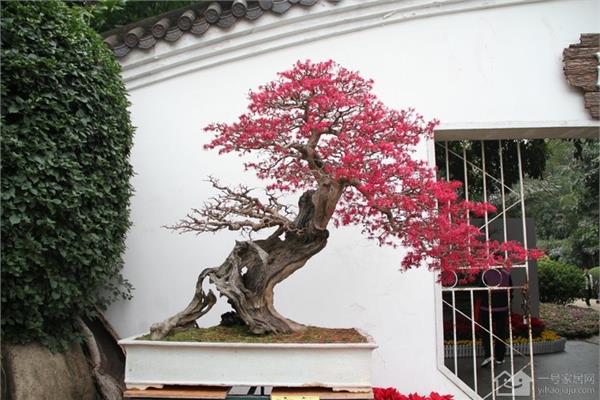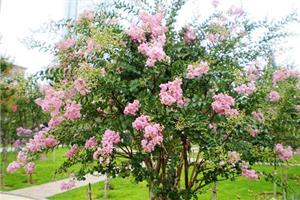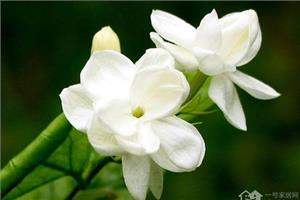Learn the 7 skills of sparrow plum bonsai maintenance to be a qualified flower escort
Finch plum can be used as hedges and vertical greening materials in gardens, and it is also suitable for allocation in mountains and rocks. this plant has strong adaptability, loose requirements for soil quality, acid, neutral and calcareous soil can adapt, and is resistant to drought, moisture and barren. These characteristics of sparrow plum make it one of the most popular bonsai plants. Next, let's learn about the conservation of sparrow plum bonsai.

Maintenance knowledge of sparrow plum bonsai
1. The basin soil should be good: the sparrow plum stump originally grew in the wild area, with well-developed roots, drought and waterlogging resistance, once it was dug up by people and planted in a shallow basin close at hand, the growth conditions were limited, such as improper maintenance and easy death, so it should be taken care of very carefully. To choose a well-drained flower paste, during maintenance, the basin soil had better be thicker. Change the new soil every two years and apply some base fertilizer to protect the fertile soil in order to make the pile scene grow normally.
2. Temperature: Finch plum bonsai has poor cold resistance, easy to freeze and dry up, and even die. Therefore, the winter should be kept indoors, and pay attention to ventilation, the room temperature should be kept above 5 ℃; when the room temperature exceeds 25 ℃, the window can be opened to avoid excessive growth caused by high temperature; when the room temperature is less than 5 ℃, the plastic insulation can be set (the greenhouse is higher than 5 ℃, that is, remove the plastic bag) when the room temperature is less than 0 ℃, the heating method such as hot water should be used to ensure the Finch plum bonsai to survive the winter safely.
3, fertilization: Finch plum bonsai can be used cake fertilizer, kitchen waste in the tank sealed fermentation, take the upper layer of fertilizer and water to add water 4Mel 5 times dilution. Sparrow plum is an acid-loving plant, which should be applied only by adding 1% ferrous sulfate to the retting fertilizer and water; spraying urea with a concentration of 0.1% Murray twice during sprouting; spraying 0.1% color 0.2% potassium dihydrogen phosphate before and after flowering.
4. Watering: be careful not to make the basin soil too wet or too dry. Water once in the morning and once in the evening in the summer. In order to shorten the branches and leaves and make the shape more beautiful, the water can be properly controlled in spring and summer.
5. Turning the basin: Finch plum bonsai 3muri-4 years turn the basin once. Before sprouting in spring, it is appropriate to cut off part of the old roots, withered roots and overgrown and dense roots, replace the old soil with 1Comp2, and cultivate fertile and loose culture soil to promote the growth and development of new roots.
6. Pruning: sparrow plum is very resistant to pruning, which can be pruned once a year after autumn to remove some overdense branches and cut off all kinds of messy branches or growing branches, so as to maintain a certain styling posture and promote its luxuriant branches. The sprouting power of sparrow plum is very strong, so the heart should be picked in time to make axillary buds germinate lateral branches. the more times they pick, the denser the branches and leaves.
7. Prevention and control of diseases and insect pests: longicorn beetles, commonly known as "heart bugs", are common pests in sparrow plum stumps. The female longicorn beetle bites through the bark to lay eggs on the branches, and the newly hatched larvae eat under the bark and grow into the trunk and roots. the damaged plants are often eaten and withered. During the prevention and control, the position of the insect pest can be judged according to the feces, and the larvae can be stabbed with appropriate iron wire, or the cotton ball plug wormhole can be soaked with 200 times solution of dichlorvos, the larvae can be poisoned with medicine, and then sealed with wet mud. Red spider, also known as fire spider, is also a common pest of Finch plum pile scene, its body is less than 1 mm, orange-red or reddish brown oval. The red spider forms a web on the plant leaves and uses its mouthparts to pierce into the branches and leaves to absorb juice, the chlorophyll of the damaged leaves is destroyed, the color becomes yellow and pale, the leaves show fine gray-yellow spots, the leaves gradually wither and fall, and some even the whole plant leaves are stripped and withered. Can spray dichlorvos or dimethoate 1000 times liquid to 1500 times liquid, eliminate it.
Sparrow plum bonsai pay attention to maintenance in winter, can keep the leaves do not fall off, evergreen all the year round, its roots knot, branches horizontal oblique, leaves small color green, the shape is very ancient and elegant, it can be seen that this plant can become one of people's favorite bonsai plants is not without reason.
The above is the relevant introduction of this article, I believe you have a simple understanding of this after reading it, if necessary, you can continue to pay attention to the No. 1 home network for more information.
- Prev

Morphological characteristics of crape myrtle what is the cultivation method of crape myrtle
Morphological characteristics of crape myrtle what is the cultivation method of crape myrtle
- Next

The reason for the delay of flowering time of Gardenia jasminoides
The reason for the delay of flowering time of Gardenia jasminoides
Related
- Wuhan Hospital Iron Tree Blooming Result Was Instantly Frightened by the Gardener Master
- Which variety of camellia is the most fragrant and best? Which one do you like best?
- What is the small blue coat, the breeding methods and matters needing attention of the succulent plant
- Dormancy time and maintenance management of succulent plants during dormancy
- Minas succulent how to raise, Minas succulent plant pictures
- What are the varieties of winter succulent plants
- How to raise succulent plants in twelve rolls? let's take a look at some experience of breeding twelve rolls.
- Attention should be paid to water control for succulent plants during dormant period (winter and summer)
- Watering experience of twelve rolls of succulent plants
- Techniques for fertilizing succulent plants. An article will let you know how to fertilize succulent plants.

